Square bronze Ding first appeared in the early Shang period, became prevailing in the later Shang period and the early West Zhou period, and gradually vanished after the middle period of West Zhou. The “Nine Dings” literally Nine Tripod Cauldron”, which was recorded in ancient Chinese texts, and an emblem of the Supreme Power, should have been Fang Ding, the square or rectangular Dings. And Mr. Zhang Guangzhi, a noted archaeologist has covered the “Nine Dings” in his works. Mr. Zhang believed that one of features of the ancient Chinese civilization was is dividing the world into Heaven and Earth, which was linked up by the important media – Shamans. According to the ancient documents, the media, by which the shamans communicated with the Heaven and the Earth, includes mountains, trees, animals, and etc. Zuo Zhuang, or, Chronicle of Zuo, a famous ancient Chinese historical document stated that casting the Nine Dings in the ancient aimed at connecting with the Heaven and the Earth. Mr. Zhang suggested that the bronzes had probably played an important role in the early political structures. Hence, it is conceivable what an important position the peculiar vessel as this kind of Fang Ding held in Shang and Zhou court.
Many scholars held that the rectangular bronzes were generally found exclusively in the graves of the high-ranking occupants, such as Fu Hao’s tomb, in which quite a lot of rectangular articles were discovered. Fu Hao, consort of the King Wu Ding of Shang, enjoyed a very high social status. Archaeological findings proved that most of the tombs, in which bronze rectangular Dings were uncovered, had comparatively larger tomb chambers, and features sets of bronze ritual vessels buried. The size and shape of the rectangular Dings depended on the quantity and quality of the bronze ritual vessels uncovered. Specifically, Mr. Yang Baocheng classified the rectangular Ding as three types: large, medium, small; the large is over 50 cm high totally; the medium is 20—50 cm in overall height, the small is less than 20 cm.
As for the function of rectangular Ding, the majority of the scholars viewed it as for offering ceremony, while others regarded it as one of the cooking utensils. In my opinion, considering the burnt marks on the base of the rectangular Dings, and the animal bones inside some Dings though no burnt marks remained, I reasoned that the rectangular Dings should have had various purposes.
The casting technique of the rectangular Ding has been spotlight in the academics. Mr. Su Rongyu and Mr. Hua Jueming have ever made a detailed analysis of it[3] . Simply put, the basic casting process of the rectangular Ding is not much different with that of other bronze wares, all of them were made by means of the dominant technique—Piece-mold casting craftsmanship.
The rectangular Dings of the Shang and Zhou period, albeit few in number, had a variety of types, and displayed an unique development trajectory. Hence, by selecting some Fang Dings for a comparison, I made a comprehensive study to elucidate the variation of Fang Dings as follows:
Rectangular Ding with Beast-mask Motif, excavated in 1974 at Zhang Zhai Southern Street, Zheng Zhou city,Henan province, early Shang period, H. 100cm, W.60.8cm, Mouth length 62.5cm. It has a basically square mouth, flat bottom, and hollowed legs, with beast-mask motif in eight groups, and raised bosses embellished on the body. This is the largest one of the early Shang bronze wares. And its companion with the identical ornament and shape, smaller in size, as follows:
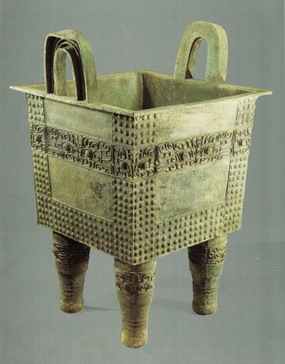
And its companion with the identical ornaments and shape, smaller in size, as follows:
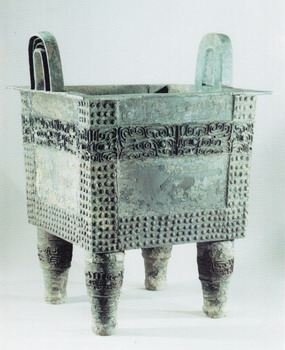
Tetrapod Cauldron with Beast-mask Motif unearthed at Xiangyang Islamic Food plant, Zhengzhou city in 1982. Early Shang dynasty. H. 81cm, Mouth length: 55cm, W. 53cm. It has a straight mouth, flat bottom, and hour hollowed cylindrical legs. Frieze of beast-mask motif and bosses were embellished on the body with burnt marks on the base. Another object excavated from the same site shares the roughly same shape, size and pattern.
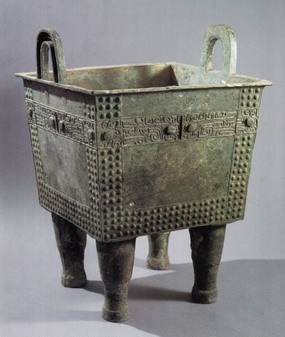
Tetrapod Cauldron with Beast-mask Motif unearthed at Qianzhuang village, Pinglu, Shanxi province in 1990. Early Shang period, H. 82cm, side length of rim: 50cm. Square body, flat bottom, hollowed cylindrical legs, with beast-mask motif and bosses were embellished on the body.
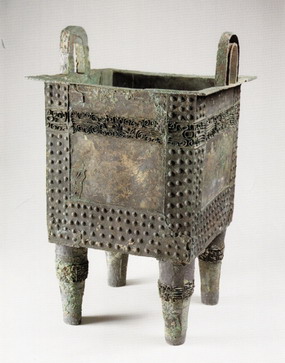
Simuxin Tetrapod Cauldron, one of the well-known masterpiece, was found in the Anyang, Henan province. Late Shang period. H. 80.1 cm, the size of rim: 64×48 cm. The height of the leg is 31 cm. The shape of the rim is rectangular, with a flat bottom and cylinder hollow legs. The hollow part of the leg is 28 cm deep. Beast-mask motif and bosses were embellished on the body. Besides, a new form of ornamentation- notched flanges appeared.
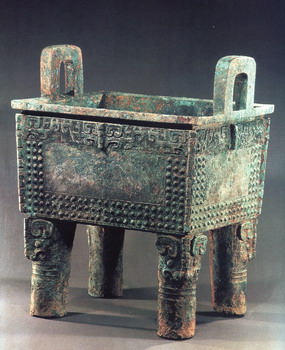
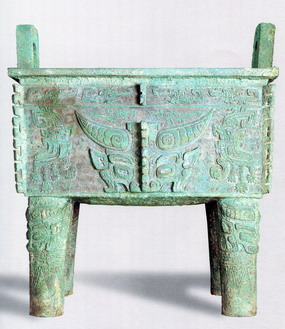
It is said that Simuwu Quadripod (it has been officially renamed "Houmuwu Quadripod") was found in 1939 at Wuguanbei of Anyang, Henan province. Its period is late Shang Dynasty. Height: 133 cm, Size of rim: 116×79 cm, Weight: 875 kg. It is the heaviest bronze ware known of Shang Dynasty so far. It has a rectangular body, deep belly, flat bottom, hollow cylindrical legs. Beast masks, and notched flanges were decorated on the body and the legs.
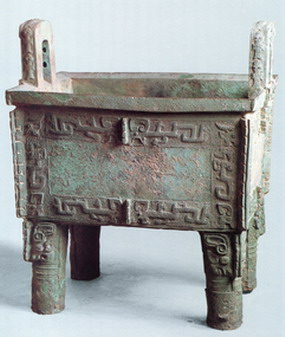
The aforementioned 4 Fang Dings shared approximate period, shape, patterns, and etc with the Tetrapod Cauldron with Taotie-mask and Boss Pattern, which is the title of this paper. All of them, feature a basically square shape, are early Shang period vessels, with similar handles, and beast masks and bosses as the main pattern. The last three objects were excavated in Anyang city, Henan province, belonged to late Shang period. Therefore, we can find that some changes had occurred in terms of the shape and motifs in this period, of which the most striking aspects were the transformation of square into rectangular, newly appeared notched flanges, and more motifs than before.
After the early Shang period, a variety of Fang Dings were progressively developed. Mr. Yang Baocheng has conducted a survey of over one hundred bronze Fang Dings unearthed over the past decades, and classified all bronze Fang Dings of the whole Shang and Zhou period into three categories as A, B, C; and six phases[4].The first phase is early Shang period; the second belongs to the early period of late Shang dynasty; the third to the late period of later Shang dynasty; the fourth to the early Zhou dynasty; the fifth to the mid-Western Zhou period; the sixth to the late Western Zhou dynasty.
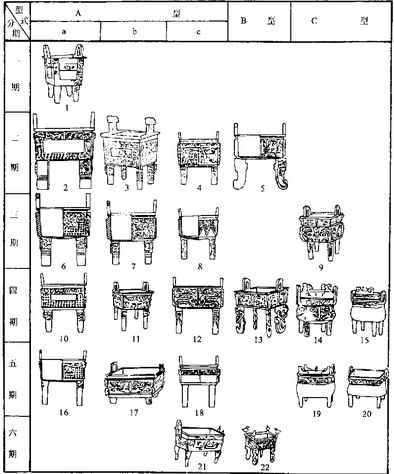
The Tetrapod Cauldron with Taotie-mask and Bosses Pattern belongs to type A, is in the first phase. The evolution of this type of Fang Ding can be concluded from the above illustration as the followings: the belly was evolved into rectangular from square; the handles were moved to the body from the rim of the mouth; changes also took place on the form of the legs, the more and more ornamenting patterns gradually came into being. Apparently, by the illustration, the bronze Fang Dings (Tetrapod Cauldrons) began to decline, which was likely caused by the ritual reform launched during King Mu of Zhou.
The Tetrapod Cauldron with Taotie-mask and Bosses Pattern was excavated from a bronze hoard at Nanshunchengjie Street, Zhengzhou city, quite a few other rare bronze treasures were discovered simultaneously, then what did the hoard was made for?
Answer for reference: some experts viewed it as a sacrifice hoard formed after a grand sacrificing ceremony in Shang period, thus it was for sacrifice.
Additionally, it was formed probably in the case of dangers, the royal family confronted with, and could not take them away and consequently buried underground.
Your answer please, if you have any questions or answer, please fell free to send us email, we are waiting for your answers and participation, and your comments, answers and suggestions will be highly appreciated. We will select and publicize the most appropriate answers and comments some time in the future.
Weekly Selection Email: meizhouyipin@chnmus.net
The Bronze Hoards at Nanshunchengjie Street in Zhengzhou
Three hoards have been discovered at the Capital Site of Shang dynasty in Zhengzhou city, and bronze wares were founded in all of the three pits. The hoard which the Tetrapot Cauldron with Taotie-mask and Bosses Pattern was found, at the Nanshunchengjie Street, was one of the hoards.
The Nanshunchengjie bronze hoard locates some 50 meters outside the western wall of the Capital Site of Shang Dynasty in Zhengzhou, connects with “Du Ling”. The pit is 4.26 meters deep. The west part of the pit is nearly rectangular, while the east part is irregular oval. And it is 2.1 meters long from east to west, 0.65---1.2 meters wide from north to south.
Two layers of mud were found in the pit, the upper layer saw bronze wares, potteries, and stamped hard potteries, which included 12 bronze vessels, of which were 4 tetrapod cauldrons; all of the potteries were containers. In the lower layer, the potteries were dominant, companied by a few bronzes, stone wares, bones, primitive earthen wares, as well as and stamped hard potteries. This hoard is of great significance. [5]
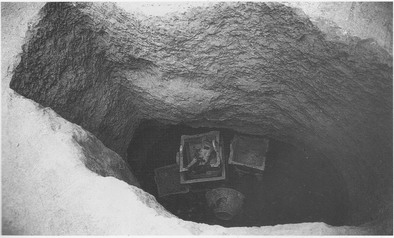
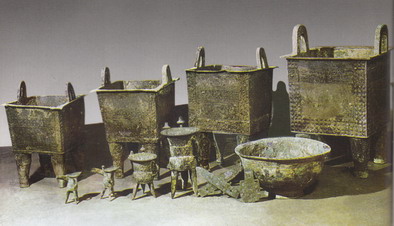
[1] [5] The Bronze Hoards in the Shang Capital Site of Zhengzhou. By Henan provincial Institute of Cultural relic and Archaeology, Zhengzhou Municipal Institute of Cultural relic and Archaeology. Science Press,1999.
[2] Zhang Guangzhi. Six Topics on Archaeology. Salian Bookstore, 2010.
[3] Su Rongyu、Hua Jueming. The Chinese Metallurgical Technology in Remote Antiquity. Shandong Science and Technology Press, 1995.
[4]Yang Baocheng. The Research on Yinxu Culture. Wuhan University Press, 2002.
In 1996, a hoard of bronzes of 12 bronze vessels was discovered at a construction site,which includes this Tetrapod Cauldron(Fang Ding ,rectangular or square Caldron)with Taotie-mask and Boss pattern focused on in this paper.
This Tetrapod Cauldron has a basically square mouth, a roughly flat bottom, and 4 hollowed cylindrical legs, with very neat interior walls. The clearly visible mold-casting junctions could be found on the rims, interior walls, the bottom, and the connecting part of the belly and the legs. The surface of the belly was embellished with groups of Taotie motifs which formed eight Taotie-pattern blocks, and three friezes of nipple-nail (Chinese name, i.e. raised-dot, or boss) pattern. Taotie masks were also applied on the upper part of the legs.
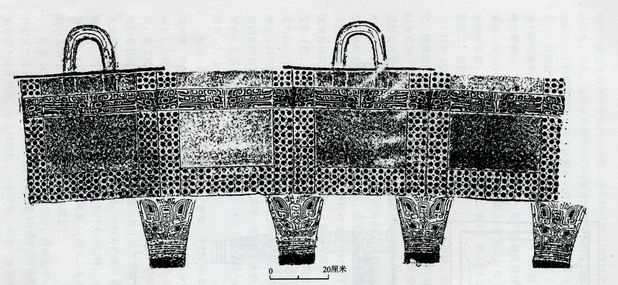
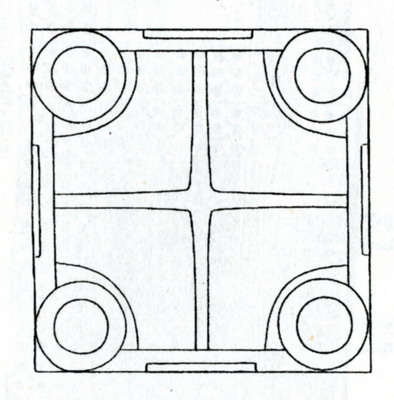
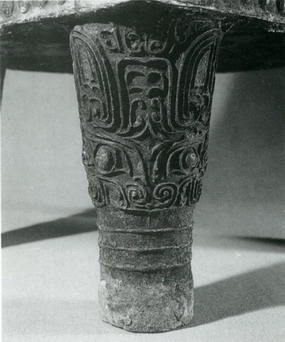
The bottom of this square Ding bears the burnt marks. Few of bronze wares with large size of the early Shang Period have been found, possibly, due to the early Shang period mausoleums of the King-class have not been discovered.
Most of the collections, companions with this bronze square Ding with Taotie and Boss motif, unearthed from the bronze hoard which is nearby the Zhengzhou Shang Ruin, were identified to be precious bronze wares, which provided us with some hint of the royal bronzes of the early Shang period, and they are of great significance to explore the ritual system in Shang dynasty.
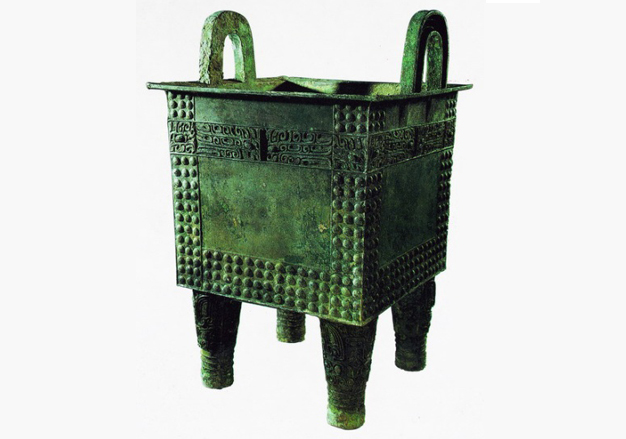
Title:Tetrapod Cauldron (Fang Ding) with Taotie-mask and Boss Pattern
Category:Bronze ritual vessel;
Time:Early Shang period;
Measurements:Height:83cm,mouth:51.5×51.2cm, weight: 52.9kg;
Provenance:Excavated at Nanshunchengjie Street, Zhengzhou city, Henan province, in 1996.
